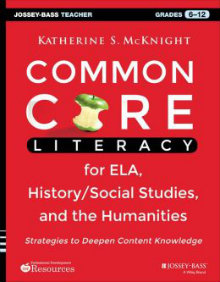Common Core Strategies: ELA and Beyond
Common Core Literacy for ELA, History/Social Studies and the Humanities: Strategies to Deepen Content Knowledge
By Katherine S. McKnight
(Jossey-Bass/Wiley, 2014 – Learn more)

As a new sixth grade Social Studies teacher I have an ever-expanding educational library that includes titles ranging from classroom management to dated books on educational psychology. Wading through it all is necessary as I learn and grow as an educator. I find some of the material useful in the theoretical sense, some in practical aspects, and others I will never look at again.
What I found in Katherine S. 
Common Core Literacy is, of course, rooted in theory and written by a professional with many years of experience. But it is far from long-winded. The book connects to the various relevant Common Core standards and also serves as a pedagogical guide for those of us who are new or veterans looking for something new. You can either read this book cover to cover or utilize bits and pieces (although the way in which it is written makes for an easy read and you will get through the content in no time).
My entry into teaching this past year was not the most traditional. I started as a building substitute because the sixth grade Social Studies teacher was out with illness. She came back for a few weeks but ended up in an intensive care unit.
The principal gave me freedom to design my own lessons while, personally, I tried to maintain the integrity of her curriculum. Unfortunately, and at a great loss to the school district, this teacher passed away over winter break after 50-plus years of service. I would be welcoming the students back after break, and I knew this was going to be a difficult transition for them (and for me).
When we returned to school, they were upset but handled the transition very well, and I slowly became their Social Studies teacher. I had changed the classroom around a little and was attempting to alter some of the routines and activities without being too abrupt. It was a difficult yet unbelievable opportunity for me, and with the cards of thanks I received on the last day of school I think I succeeded in making their sixth grade Social Studies experience worthwhile.
It wasn’t all roses – this book would have helped
I mention the above story because, as veteran teachers and others with a similar experience know, it was not all roses. Some of my lessons fell way short of what I had hoped. I had some previous, albeit limited, experience in education, but nothing prepares you for a middle school class (except being in a middle school class).
To stand in front of a group of eleven year olds and feel a bit intimidated is an awkward thing. I knew I wanted them to end the school year with a greater appreciation for history and the work of historians. I wanted them to have a strong foundation in historical thinking and literacy; but how would I get them there? I wish I had had Dr. McKnight’s book in January.
Common Core Literacy covers all the aspects of the standards including reading, writing, listening, and speaking. The book includes examples of all the strategies mentioned. The strategies are introduced with an indication of their difficulty, followed by a step-by-step explanation, and finally a connection to the CCSS.
I am really looking forward to using one idea, the GIST reading comprehension strategy, in September. This strategy’s explanation begins with a medium difficulty designation, followed by a brief introduction, a list of steps, and a connection to the CCSS; the next three pages include a blank example, an ELA example and a Social Studies example. There is also a website with blanks to be printed out.
Technology included too
It has become absolutely imperative that technology be incorporated into all aspects of education. Technology is no longer relegated to a computer or technology class that students may only access periodically. Students should be using technology in all classes in order to gain a greater understanding of the many uses it can have in their life and work.
McKnight spends ample time explaining how to incorporate technology and also provides links to helpful websites. The useful technology includes everything from using Google docs to a website that allows students to create graphic novels. I am excited to try my hand at using some this year.
Well, I can not state it strongly enough: Common Core Literacy deserves a place on the bookshelf of all educators in the Humanities. It is certainly a book I will be using as I plan my lessons for the year. As McKnight mentions several times throughout the book, “good teachers tinker,” and if you have the desire to tinker I recommend getting your hands on this book.
Michael DiClemente is a sixth grade Social Studies teacher at the Andrews Middle School in Medford, Massachusetts. Michael has a master’s degree in history and is involved in the local historical community. He presents a few times a year at local history conferences. Michael has been involved in the Dante Alighieri Society, an international Italian cultural organization, for some time and was recently voted secretary.





































What a wonderful review, Mike! (Mike is my “partner in crime” co-teaching Ancient History. He took over when a dear friend and colleague passed away unexpectedly last Christmas.)
Thanks for the feedback, Mike. Great insight into the book.